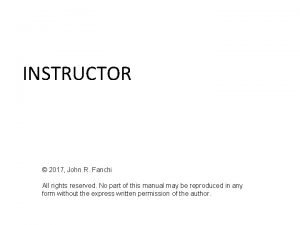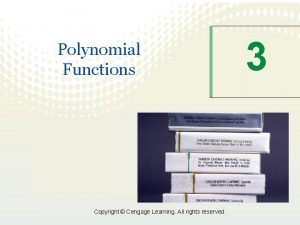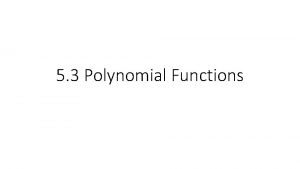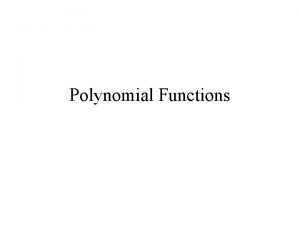Polynomial Functions Copyright Cengage Learning All rights reserved










































- Slides: 42

Polynomial Functions Copyright © Cengage Learning. All rights reserved. 3

3. 4 ZEROS OF POLYNOMIAL FUNCTIONS Copyright © Cengage Learning. All rights reserved.

What You Should Learn • Use the Fundamental Theorem of Algebra to determine the number of zeros of polynomial functions. • Find rational zeros of polynomial functions. • Find conjugate pairs of complex zeros. • Find zeros of polynomials by factoring. • Use Descartes’s Rule of Signs and the Upper and Lower Bound Rules to find zeros of polynomials. 3

The Fundamental Theorem of Algebra 4 4

The Fundamental Theorem of Algebra You know that an nth-degree polynomial can have at most n real zeros. In the complex number system, this statement can be improved. That is, in the complex number system, every nth-degree polynomial function has precisely n zeros. This important result is derived from the Fundamental Theorem of Algebra. 5

The Fundamental Theorem of Algebra Using the Fundamental Theorem of Algebra and the equivalence of zeros and factors, you obtain the Linear Factorization Theorem. 6

The Fundamental Theorem of Algebra Note that the Fundamental Theorem of Algebra and the Linear Factorization Theorem tell you only that the zeros or factors of a polynomial exist, not how to find them. Such theorems are called existence theorems. Remember that the n zeros of a polynomial function can be real or complex, and they may be repeated. 7

Example 1 – Zeros of Polynomial Functions a. The first-degree polynomial f (x) = x – 2 has exactly one zero: x = 2. b. Counting multiplicity, the second-degree polynomial function f (x) = x 2 – 6 x + 9 = (x – 3) has exactly two zeros: x = 3 and x = 3 (This is called a repeated zero. ) 8

Example 1 – Zeros of Polynomial Functions cont’d c. The third-degree polynomial function f (x) = x 3 + 4 x = x(x 2 + 4) = x(x – 2 i )(x + 2 i ) has exactly three zeros: x = 0, x = 2 i, and x = – 2 i. 9

Example 1 – Zeros of Polynomial Functions cont’d d. The fourth-degree polynomial function f (x) = x 4 – 1 = (x – 1)(x + 1)(x – i )(x + i ) has exactly four zeros: x = 1, x = – 1, x = i, and x = –i. 10

The Rational Zero Test 11 11

The Rational Zero Test relates the possible rational zeros of a polynomial (having integer coefficients) to the leading coefficient and to the constant term of the polynomial. 12

The Rational Zero Test To use the Rational Zero Test, you should first list all rational numbers whose numerators are factors of the constant term and whose denominators are factors of the leading coefficient. Having formed this list of possible rational zeros, use a trialand-error method to determine which, if any, are actual zeros of the polynomial. Note that when the leading coefficient is 1, the possible rational zeros are simply the factors of the constant term. 13

Example 3 – Rational Zero Test with Leading Coefficient of 1 Find the rational zeros of f (x) = x 4 – x 3 + x 2 – 3 x – 6. Solution: Because the leading coefficient is 1, the possible rational zeros are the factors of the constant term. Possible rational zeros: ± 1, ± 2, ± 3, ± 6 14

Example 3 – Solution cont’d By applying synthetic division successively, you can determine that x = – 1 and x = 2 are the only two rational zeros. 0 remainder, so x = – 1 is a zero. 0 remainder, so x = 2 is a zero. So, f (x) factors as f (x) = (x + 1)(x – 2)(x 2 + 3). 15

Example 3 – Solution cont’d Because the factor (x 2 + 3) produces no real zeros, you can conclude that x = – 1 and x = 2 are the only real zeros of f, which is verified in Figure 3. 31 16

The Rational Zero Test If the leading coefficient of a polynomial is not 1, the list of possible rational zeros can increase dramatically. In such cases, the search can be shortened in several ways: (1) a programmable calculator can be used to speed up the calculations; (2) a graph, drawn either by hand or with a graphing utility, can give a good estimate of the locations of the zeros; (3) the Intermediate Value Theorem along with a table generated by a graphing utility can give approximations of zeros; and 17

The Rational Zero Test (4) synthetic division can be used to test the possible rational zeros. Finding the first zero is often the most difficult part. After that, the search is simplified by working with the lower -degree polynomial obtained in synthetic division, as shown in Example 3. Recall that if x = a is a zero of the polynomial function f, then x = a is a solution of the polynomial equation f (x) = 0. 18

Conjugate Pairs 19 19

Conjugate Pairs The pairs of complex zeros of the form a + bi and a – bi are conjugates. Be sure you see that this result is true only if the polynomial function has real coefficients. For instance, the result applies to the function given by f (x) = x 2 + 1 but not to the function given by g(x) = x – i. 20

Example 6 – Finding a Polynomial with Given Zeros Find a fourth-degree polynomial function with real coefficients that has – 1, and 3 i as zeros. Solution: Because 3 i is a zero and the polynomial is stated to have real coefficients, you know that the conjugate – 3 i must also be a zero. So, from the Linear Factorization Theorem, f (x) can be written as f (x) = a (x + 1)(x – 3 i )(x + 3 i ). 21

Example 6 – Solution cont’d For simplicity, let a = 1 to obtain f (x) = (x 2 + 2 x + 1)(x 2 + 9) = x 4 + 2 x 3 + 10 x 2 + 18 x + 9. 22

Factoring a Polynomial 23 23

Factoring a Polynomial The Linear Factorization Theorem shows that you can write any nth-degree polynomial as the product of n linear factors. f (x) = an(x – c 1)(x – c 2)(x – c 3). . . (x – cn) However, this result includes the possibility that some of the values of ci are complex. 24

Factoring a Polynomial The following theorem says that even if you do not want to get involved with “complex factors, ” you can still write f (x) as the product of linear and/or quadratic factors. 25

Factoring a Polynomial A quadratic factor with no real zeros is said to be prime or irreducible over the reals. Be sure you see that this is not the same as being irreducible over the rationals. For example, the quadratic x 2 + 1 = (x – i )(x + i ) is irreducible over the reals (and therefore over the rationals). On the other hand, the quadratic x 2 – 2 = is irreducible over the rationals but reducible over the reals. 26

Example 7 – Finding the Zeros of a Polynomial Function Find all the zeros of f (x) = x 4 – 3 x 3 + 6 x 2 + 2 x – 60 given that 1 + 3 i is a zero of f. Solution: Because complex zeros occur in conjugate pairs, you know that 1 – 3 i is also a zero of f. This means that both [x – (1 + 3 i )] and [x – (1 – 3 i )] are factors of f. 27

Example 7 – Solution cont’d Multiplying these two factors produces [x – (1 + 3 i )][x – (1 – 3 i )] = [(x – 1) – 3 i ][(x – 1) + 3 i ] = (x – 1)2 – 9 i 2 = x 2 – 2 x + 10. 28

Example 7 – Solution cont’d Using long division, you can divide x 2 – 2 x + 10 into f to obtain the following. 29

Example 7 – Solution cont’d So, you have f (x) = (x 2 – 2 x + 10)(x 2 – x – 6) = (x 2 – 2 x + 10)(x – 3)(x + 2) and you can conclude that the zeros of f are x = 1 + 3 i, x = 1 – 3 i, x = 3, and x = – 2. 30

Factoring a Polynomial In Example 7, if you were not told that 1 + 3 i is a zero of f, you could still find all zeros of the function by using synthetic division to find the real zeros – 2 and 3. Then you could factor the polynomial as (x + 2)(x – 3)(x 2 – 2 x + 10). Finally, by using the Quadratic Formula, you could determine that the zeros are x = – 2, x = 3, x = 1 + 3 i, and x = 1 – 3 i. 31

Other Tests for Zeros of Polynomials 32 32

Other Tests for Zeros of Polynomials You know that an nth-degree polynomial function can have at most n real zeros. Of course, many nth-degree polynomials do not have that many real zeros. For instance f (x) = x 2 + 1, has no real zeros, and f (x) = x 3 + 1 has only one real zero. The following theorem, called Descartes’s Rule of Signs, sheds more light on the number of real zeros of a polynomial. 33

Other Tests for Zeros of Polynomials A variation in sign means that two consecutive coefficients have opposite signs. 34

Other Tests for Zeros of Polynomials When using Descartes’s Rule of Signs, a zero of multiplicity k should be counted as k zeros. For instance, the polynomial x 3 – 3 x + 2 has two variations in sign, and so has either two positive or no positive real zeros. Because x 3 – 3 x + 2 = (x – 1)(x + 2) you can see that the two positive real zeros are x = 1 of multiplicity 2. 35

Example 9 – Using Descartes’s Rule of Signs Describe the possible real zeros of f (x) = 3 x 3 – 5 x 2 + 6 x – 4. Solution: The original polynomial has three variations in sign. f (x) = 3 x 3 – 5 x 2 + 6 x – 4. 36

Example 9 – Solution cont’d The polynomial f (–x) = 3 (–x)3 – 5 (–x)2 + 6 (–x) – 4 = – 3 x 3 – 5 x 2 – 6 x – 4 has no variations in sign. So, from Descartes’s Rule of Signs, the polynomial f (x) = 3 x 3 – 5 x 2 + 6 x – 4 has either three positive real zeros or one positive real zero, and has no negative real zeros. 37

Example 9 – Solution cont’d From the graph in Figure 3. 35, you can see that the function has only one real zero, at x = 1. Figure 3. 35 38

Other Tests for Zeros of Polynomials Another test for zeros of a polynomial function is related to the sign pattern in the last row of the synthetic division array. This test can give you an upper or lower bound of the real zeros of f. A real number b is an upper bound for the real zeros of f if no zeros are greater than b. Similarly, b is a lower bound if no real zeros of f are less than b. 39

Other Tests for Zeros of Polynomials 40

Other Tests for Zeros of Polynomials Here are two additional hints that can help you find the real zeros of a polynomial. 1. If the terms of f (x) have a common monomial factor, it should be factored out before applying the tests in this section. For instance, by writing f (x) = x 4 – 5 x 3 + 3 x 2 + x = x(x 3 – 5 x 2 + 3 x + 1) you can see that x = 0 is a zero of f and that the remaining zeros can be obtained by analyzing the cubic factor. 41

Other Tests for Zeros of Polynomials 2. If you are able to find all but two zeros of f (x), you can always use the Quadratic Formula on the remaining quadratic factor. For instance, if you succeeded in writing f (x) = x 4 – 5 x 3 + 3 x 2 + x = x(x – 1)(x 2 – 4 x – 1) you can apply the Quadratic Formula to x 2 – 4 x – 1 to conclude that the two remaining zeros are x = 2 + x=2–. 42
 Copyright 2015 all rights reserved
Copyright 2015 all rights reserved Copyright 2015 all rights reserved
Copyright 2015 all rights reserved Dell all rights reserved copyright 2009
Dell all rights reserved copyright 2009 Copyright © 2018 all rights reserved
Copyright © 2018 all rights reserved Cengage chapter 7
Cengage chapter 7 Specification by example
Specification by example All rights reserved sentence
All rights reserved sentence Creative commons vs all rights reserved
Creative commons vs all rights reserved Confidential all rights reserved
Confidential all rights reserved Sentinel repetition
Sentinel repetition 2012 pearson education inc
2012 pearson education inc Microsoft corporation. all rights reserved.
Microsoft corporation. all rights reserved. Microsoft corporation. all rights reserved
Microsoft corporation. all rights reserved Microsoft corporation. all rights reserved.
Microsoft corporation. all rights reserved. Pearson education inc. all rights reserved
Pearson education inc. all rights reserved Warning all rights reserved
Warning all rights reserved C all rights reserved
C all rights reserved Quadratic equation cengage
Quadratic equation cengage Warning all rights reserved
Warning all rights reserved Confidential all rights reserved
Confidential all rights reserved Microsoft corporation. all rights reserved
Microsoft corporation. all rights reserved Pearson education inc. all rights reserved
Pearson education inc. all rights reserved 2017 all rights reserved
2017 all rights reserved Pearson education inc all rights reserved
Pearson education inc all rights reserved 2010 pearson education inc
2010 pearson education inc Confidential all rights reserved
Confidential all rights reserved Airbus deutschland gmbh
Airbus deutschland gmbh R rights reserved
R rights reserved Rights reserved
Rights reserved Delmar cengage learning medical terminology
Delmar cengage learning medical terminology Medical terminology chapter 5 learning exercises answers
Medical terminology chapter 5 learning exercises answers Cengage learning heart diagram
Cengage learning heart diagram South-western cengage learning
South-western cengage learning Chapter 13 medical math assignment sheet
Chapter 13 medical math assignment sheet 2009 delmar cengage learning
2009 delmar cengage learning Cengage learning heart diagram
Cengage learning heart diagram Medical terminology chapter 1 answer key
Medical terminology chapter 1 answer key Cengage learning australia
Cengage learning australia Measuring and recording apical pulse
Measuring and recording apical pulse Cengage learning
Cengage learning Cengage learning
Cengage learning Wadsworth cengage learning
Wadsworth cengage learning Cengage learning
Cengage learning


































































